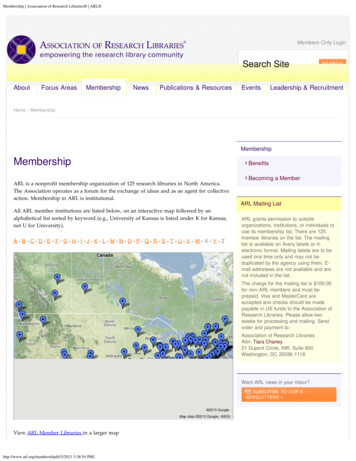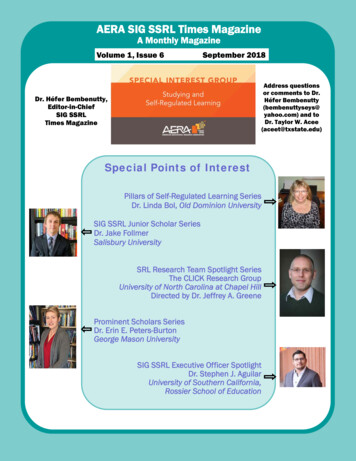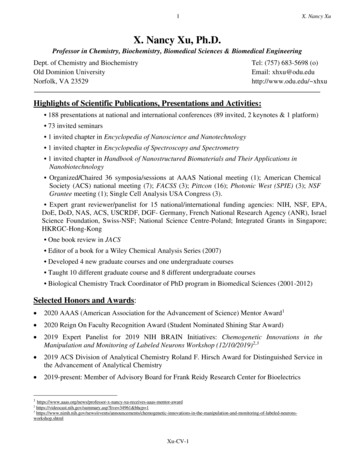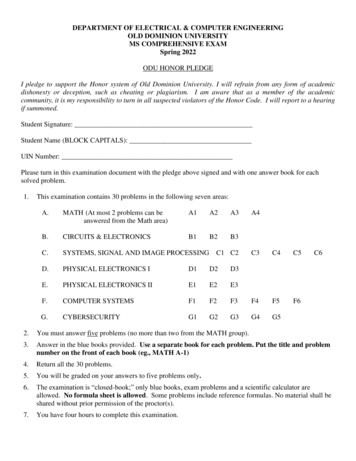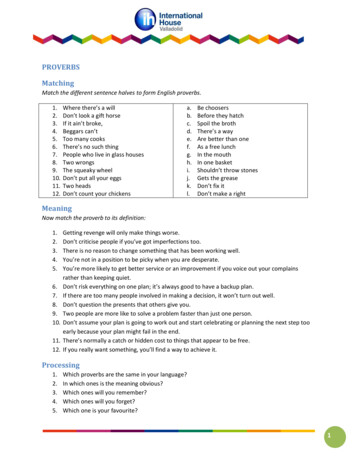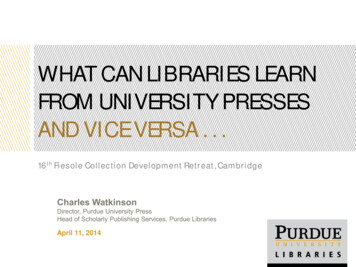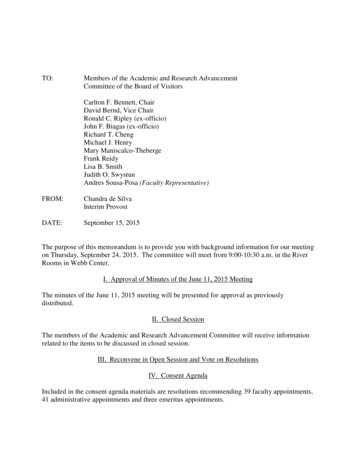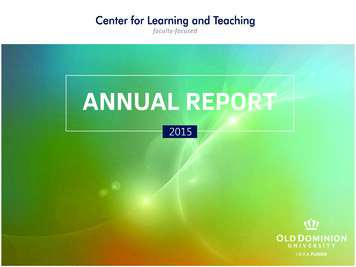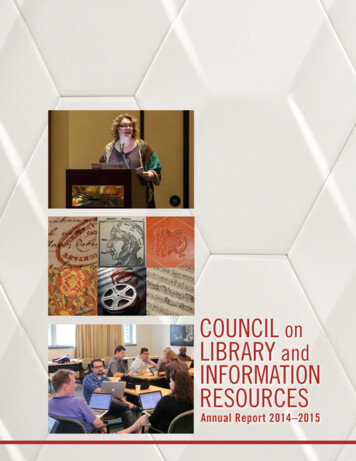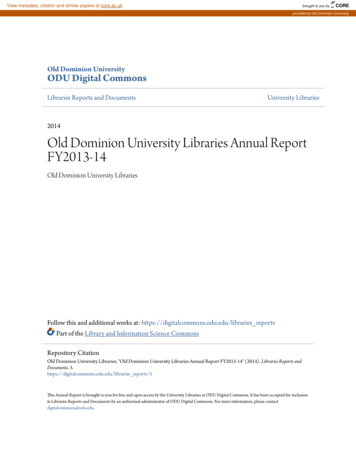
Transcription
View metadata, citation and similar papers at core.ac.ukbrought to you byCOREprovided by Old Dominion UniversityOld Dominion UniversityODU Digital CommonsLibraries Reports and DocumentsUniversity Libraries2014Old Dominion University Libraries Annual ReportFY2013-14Old Dominion University LibrariesFollow this and additional works at: https://digitalcommons.odu.edu/libraries reportsPart of the Library and Information Science CommonsRepository CitationOld Dominion University Libraries, "Old Dominion University Libraries Annual Report FY2013-14" (2014). Libraries Reports andDocuments. 3.https://digitalcommons.odu.edu/libraries reports/3This Annual Report is brought to you for free and open access by the University Libraries at ODU Digital Commons. It has been accepted for inclusionin Libraries Reports and Documents by an authorized administrator of ODU Digital Commons. For more information, please contactdigitalcommons@odu.edu.
Old Dominion UniversityUniversity Libraries Annual ReportFY2013-14Our Mission:Our Vision:“The Library promotes student and faculty success inlearning, teaching, and research. We build, manage,and preserve research and information collections;serve the information needs of our community in awelcoming physical and virtual environment; and createand foster collaborative opportunities for research andservice.”“The Library is the center of the University’sintellectual, cultural and social life. We are clientcentered and future oriented. We are recognized asthe premier research library of southeastern Virginia.We provide leadership to the community throughknowledge and resources. “Our Values: We affirm our commitment toThe transformative nature of teaching and learningCollaboration, cooperation and teamworkExcellence in serviceRecognition, development and empowerment of staffResponsible stewardshipRegard for diversity of people and of ideasEthical practicesChange and innovation for the benefit of our communityContents:HighlightsTeaching and Other ServicesCollections SupportOperationsFacilities Services and SupportCommunity EngagementLooking ForwardHighlightsPreparing for change this year, the University Libraries launched the first 4 phases of its 18-month futureplanning process. In Phase 1, Self-Discovery, participating staff explored their MBTI (Myers-Briggs TypeIndicator) preferences in handling tasks and relationships. In Phases 2 and 3, some participants focusedon the internal and the other half focused on the external academic library and higher educationenvironments. Campus faculty and administrators partnered with Library staff in exploring a series ofextreme scenarios in Phase 4 to sharpen thinking about overarching themes and recurringopportunities. Phases 5, 6 and 7 to set strategic directions and to create a 5-year operational plan forthe Libraries will roll out in FY2015.Virginia S. O’Herron, University Librarian since 2004 and a member of the University community since1993, announced her intention to retire. Her extended leave began at the end of June, in advance of1
her formal retirement date of July 31, 2014. Staff members completed succession planning for unitsand departments, developed and carried out training programs, and worked closely with her to ensure asmooth transition in all areas. George Fowler, Associate University Librarian for Information Resourcesand Technology, began unofficial service as Interim University Librarian at the end of June. He willofficially become the interim University Librarian on July 1.Perry Library again extended building service hours. Learning Commons usage continued to grow. InFY2013, the facility opened to students for a total of 5,933 hours out of the possible 8,760 hours in theyear. In FY2014, with onetime University funding, the facility opened for service 6,206 hours, anincrease of 273 hours.FY2014 BuildingEntrancesPerry LibraryDiehn ComposersRoomHofheimer ArtLibraryUniversity Librariestotal 6941,3121,011,292University Libraries Entrances: FY2007 - 000Hofheimer Art LibraryDiehn Composers RoomPerry LibraryFY2007 FY2008 FY2009 FY2010 FY2011 FY2012 FY2013 FY20142
FY2014 University LibrariesAnnual Statistical Report:Service UsageHelp desk reference transactionsConsultationsInterlibrary loan items acquiredfor ODU usersInterlibrary loan items sent toother librariesItems delivered to ODU patronsfrom the ODU collectionsLearning Commons equipmentloansCourse based instruction sessionsOrientations and toursWorkshopsLearning Commons programsEventsExhibitsVirtual reference 213,134264823533330274,439The Hofheimer Art Library relocated to the newly constructed Barry Art Building on Monarch Way at theclose of FY2014. The Art Library’s second floor home is beautiful, with new furniture, shelving, andequipment. By the time fall semester classes begin, the Library, faculty offices, labs, and classrooms willbe ready for arriving students.The Libraries passed its 10 year University audit of Library financial and other procedures with norecommendations. To support that process, staff set up centralized files for review, met with theUniversity auditor to describe library practices and services, demonstrated specific processes, andanswered questions. The Libraries’ longtime investment in developing standardized practices andworking closely with appropriate University agencies resulted in the conclusion that its processes meetUniversity expectations.3
Teaching and Other ServicesThe University Libraries are committed to supporting student learning and faculty teaching. TheLibraries provide a suite of instructional programs and services designed to meet student needs, both onand off campus. Help Desk services provide face to face assistance to students for technical help,construction of effective search strategies for research in the disciplines, navigation of campuscomplexities, selection of best resources, and for many other questions. Online services provide realtime individual assistance, detailed guides, individual course lists, videos, search tools, finding aids andother instructional products. The Libraries offer consultation with faculty, class instruction and otherassistance, specialized workshops, and various outreach activities. As part of its culture of assessment,the University Libraries continued to focus on enhancement of teaching and support services.Instruction ProgramsLibrary instruction programming is based on defined research concepts. Student learning outcomesalign with the information literacy standards developed by the Association of College and ResearchLibraries. Instructional programs primarily target three types of standardized campus instruction – theUniversity’s General Education program information literacy emphasis; General Education’s Englishcomposition classes for lower level undergraduates; and discipline-based classes for upper levelundergraduate and graduate students.Within this programming, Library instructors assess effectiveness and experiment with new ideas andproducts. Their instructional assessment process is cyclical. First: initial assessment, practice, andinstructor reflection on successes and concerns. Second: implementation of improvement methods.Third: assessment of the impact of those improvements. In this cohesive cycle, the instructor observesthe process, initiates improvements, observes anew, and reflects on ideas and new approaches withother instructors.The University Libraries supplement formal classroom instruction with specialized workshops, generalorientations, and tours. This year, faculty and graduate student workshops highlighted citationmanagement software, disciplinary resources, NBCLearn, and journal metrics. Undergraduateworkshops examined general learning skills such as citing sources, avoiding plagiarism, and evaluatingweb sources.Library staff used many resources to strengthen teaching and assessment. The accessibility andfunctionality of the University’s new Qualtrics survey tool provided staff with an effective system forcapturing faculty perceptions of instructional effectiveness in the library sessions. Faculty responserates improved, and faculty provided more qualitative comments about the sessions. Other instructiontools included Prezi, Poll Everywhere, new course guides offered in LibGuides, group activities, quizzes,and games to enhance learning.4
Library instructors expanded basic teaching programs. For the first time, staff offered library instructionto the ENGL 110 classes which incorporate research-based assignments. For this new program, staffdesigned curriculum content to cover 4 main topic areas for this new set of classes, and taught 18sessions during FY2014. These courses extended the reach of library instruction to more students at anearly stage in their academic careers. Instructors benefited from the opportunities to continueexploration of instructional techniques and organization.Librarians used diverse methods to build and maintain individual instructional effectiveness this year.To support disciplinary needs during periods of staff transition, Library instructors developed astandardized, interchangeable set of curriculum plans. With this plan, the instruction team maintainedscience classes throughout the period of time needed to fill the open science reference position. Thisstandardized approach also enhanced orientation and training programs for new Library instructors.The Libraries continued to work closely with faculty members to support student learning in semesterlong classes. Two librarians embedded within new classes. While labor intensive, this in-depth outreachresults in many positive learning opportunities for those students. The experiences appear to enhanceengagement of the students with the librarians.The Learning Commons continued to partner with faculty members seeking specialized equipment forclass projects. This year, faculty members borrowed iPads to support Business 110 students tasked withcreating video commercials and also for an English 231 class interested in capturing the challenge ofwalking across Hampton Boulevard.In another innovative project, Library staff used the flipped classroom technique first explored last yearin a library session held for a theater class. This year, the new curriculum for ENGL 211 classes includedpre-session group assignments by the faculty member for a course session where each group developedand presented on the research process. In this model, responsibility for learning is placed almostentirely on the students working in small groups. The 35 sessions taught in the new method appear tohave been well received by course instructors, as evidenced by positive comments in the Qualtricsassessment surveys.5
Library Instructionsessions 5233302070189204181208264257259In LibraryGORNTOAdobe lth SciencesKaufmanSRCECSBOtherVBHECTri CitiesTotalInstructional productsThe Libraries continue to develop products to supplement instructional programming. Staff created andposted 16 one-minute videos, One Minute Tips, for quick user consultation. These videos are used inclasses, linked in Blackboard, and are used by individuals. Most run on the ODU YouTube channel andreceived more than 1,900 views during the year.The Libraries partnered with ITS and other campus agencies to acquire the Lynda.com training resourceon applications use. Access to Lynda.com is available from several locations on the campus web pagefor easy user access, and is included in the University Libraries’ A to Z database listing. Students andstaff alike may use more than 2,500 training videos.Outreach programsThe University Libraries are committed to building relationships across campus and to extendingprograms to the students. Librarians traveled to students, teaching sessions in Constant Hall, BattenArts and Letters Building, Diehn Fine and Performing Arts Building, Education Building, Student SuccessCenter, Mills Godwin Building, and the Virginia Beach Higher Education Center. They also providedonline sessions via Adobe Connect. Staff participated in orientation programs for faculty, graduatestudents, UNIV 100, and the UNIV 195 LEAP classes. Participation in student orientation programs helpsbuild early awareness of library services and resources.6
As part of outreach, three representatives from the University Libraries attended the University’sResource Fair for Residential Advisors in August of 2013 to talk with students about instructionalservices. Responding to an invitation to help provide programming for resident students, library staffpresented their first-ever dormitory workshops, offering one workshop on plagiarism and another onlibrary website content.The University Libraries’ Information Literacy Roundtable was revived for faculty in January 2014.Library staff discussed new instructional tools, provided an overview of upcoming changes in the ACRLInformation Literacy Standards for Higher Education, and solicited feedback from those teaching theGeneral Education information literacy courses.Continuing assessment feedback indicated a strong interest in fine and fee payments via credit or debitcards. Although University practice still does not grant the Library the ability to accept such payments,Library staff developed an alternate solution in partnership with the University Card Center andInformation Technology Services (ITS) for fall semester. Students may now apply funds to their MonarchPlus card via credit/debit card and then pay library debt with the Monarch card. This system appears tobe working well.In the Learning Commons, Help Desk staff continued to provide online, phone and direct help to allcustomers on a 24/5 basis. Staff managed, updated and expanded the Commons’ equipment loanservice.Librarians worked with the Colleges on program reviews, self-study documentation, and onsiteaccreditation visits as part of the suite of Library services. Contributions included:-reaccreditation report for the Environmental Health Sciences undergraduate programaccreditation review for Nursing Anesthesiologyaccreditation survey for Dental Hygieneexternal review of the Community College Leadership programaccreditation review of Park, Recreation & Tourism StudiesABET accreditation process for of the Modeling and Simulation Engineering Department7
Collections SupportThe University Libraries enhanced collections this year. Ongoing acquisition and oversight of print andonline scholarly resources supported teaching and research programs. The Libraries focused onacquisition and management of local, archival, and specialized materials. Staff continued to create anddevelop content-based digital collections.Print and online collectionsThe Libraries allocated funds to both faculty members and bibliographers to build individual disciplinaryprogram collections. The Libraries participated in the Virtual Library of Virginia (VIVA) state widemonographic collection analysis. This year, trials were set up for faculty members and other users totest out content and user functionality for 30 new online resources. From these, 8 new subscriptionswere initiated, including Birds of North America Online, PsycTESTS, AccessAnesthesiology, and Web ofKnowledge.Special collectionsDespite position vacancies within the Libraries’ Special Collections and University Archives, research andconsultation services continued this year. Staff received donations of two small manuscript collections(papers from Paula J. Miller’s election campaigns; papers of Joseph Fitzpatrick). In addition, staffcompleted processing of the Henry Howell collection.In music special collections, the Libraries conducted a review of holdings, history, and goals of thecollections. Staff inventoried collections, audited records, and identified issues. Reviews led toimproved clarification and understanding of the collections, focusing on priorities, best practices, userneeds, and articulation of realistic, achievable goals.The 12 named research collections (composers’ working papers, scores, recordings, and other materials)are the focal point of the music special collections. Online finding aids have been created for 10 of thosecollections. Content is supplemented by community collections held in the Special Collections andUniversity Archives: the Schola Cantorum Records; Virginia Symphony Orchestra Papers; VirginiaSymphony League Papers; Greater Williamsburg Virginia Symphony Society Papers; and Virginia OperaPapers.A second segment of the music collections evolved from the archival New Music Performance Collectionfor scores. An inventory project identified those scores published since 1999, when the archivalcollection was established. The 222 published scores are now being cataloged for a new circulatingcollection to be housed in the DCR Reading Room and featured as a performance collection. Unlike thearchival scores, which are governed by restrictive access guidelines, this collection will be open to allstudents and all faculty. This collection will retain the name, New Music Performance Collection. TheLibraries also allocated funds for purchasing additional titles, and will be making the new collectionavailable in FY2015.8
The remaining unpublished scores have been given a new name, the Contemporary ComposersCollection. To broaden access, the Libraries created a digital collection containing the scanned first pageof the score plus metadata description of composer and score. In addition, the Libraries initiated acampaign to solicit new pieces, sending invitations to the Fellows who participated in the DuffyComposers Institute workshops.The third segment of the music special collections contains the University’s local performances. Staffinventoried library holdings of local performance recordings and initiated a project to develop thissegment of the collection as a digital collection rather than a circulating library collection.Digital CollectionsThe University Libraries engaged this year in developing its unique, online collections. Staff establishedbest practices for streaming audio and video files, selected an accessible media player for users, creatednaming guidelines, configured Archon online finding aids, and established file management and qualitycontrol processes.Items added to digital collections climbed from 2,873 in FY2013 to more than 7,000 in FY2014. Entryand processing was completed for four collections originally created in FY2013: Oral Histories in the Perry Library- School Desegregation in Norfolk, VA- DOVE-Desegregation of Virginia Education- Revelli Memorial Band Competition Winners [music collection]Two collections were created and completed in FY2014: the Carolyn Rhodes Collection of oral histories The Independent CorrespondenceThree new collections were added in FY2014 and are still growing: the Russell Stanger Collection [photos; music collection] Norfolk Public Schools Desegregation Papers Contemporary Composers Collection [music collection]GiftsDonors contributed to book collections as well as to special and music collections. With the opening ofthe new campus Confucius Institute and Chinese Studies program came a large gift of Chinese materials.Most of its 800 books, DVDS, and other instructional materials are in Chinese. These materials wereprocessed and are available through the Libraries’ catalog in their native Asian scripts.The Library received gifts for its general circulating collections from several other donors. Dr. Carol Dollin the College of Education donated 2,000 juvenile and young adult titles. Professor Emeritus Carl Boydadded 99 volumes to his Carl Boyd Collection of the History of War. Peter Mark, Artistic Director ofVirginia Opera till 2010, donated his collection of books related to opera and musical performance.9
Access to collectionsCollections are useless if no one can access them. To enhance access, staff continued to configure theEBSCO Discovery Service to improve access to the Libraries’ collections, whether print or electronic. Thisconfiguration entailed considerable coordination between multiple vendors and the Libraries; theproject improved user experience for patrons retrieving full text from comprehensive search results.Campus users now have broader, more reliable access to academic resources.The Libraries improved access to materials not available in the University Libraries’ collections, bydeveloping a procedure in which the Libraries will pay for faculty and graduate students to purchase anindividual article as needed, through a pay-per-view program with the Copyright Clearance Center calledGet It Now. This program normally provides same-day delivery of available articles at less costly ratesthan through individual proprietary options. The service should also improve turn-around time forembargoed and other difficult to obtain articles. It appears to have had a positive impact on borrowingfill rates.The Libraries participated in the Virtual Library of Virginia (VIVA) Universal Borrowing Pilot Projectthroughout the academic year. The project authorized users at any VIVA institution to borrow printbooks held at participating institutions, such as Old Dominion University. This new project marks atransformative step in extending resources to students, faculty and staff at both public and privatehigher education institutions throughout the Commonwealth.10
OperationsThe University Libraries focused on strengthening operational support systems to maximize benefits andreduce costs. The Libraries partnered with the University in consolidating and archiving documents inthe campus Banner Document Management System – especially financial documents essential to Libraryand to other campus operations. In replacing outdated print files, this new system expanded access andsecurity while reducing storage and staffing needs. Licensing and vendor contracts were centralized inan Electronic Resources Management System; documents, metadata, addenda, sole source letters, andhistorical contract data are now easily accessible to Procurement Services and to the Libraries fornegotiation and contract management purposes.The Libraries launched an ambitious project this fiscal year to establish SharePoint for centralized filemanagement. Much of the year was spent on training in SharePoint organization and administrationprotocols, cleaning up old files, consolidating files, and preparing an organizational structure for filemaintenance in the future. With foundations firmly in place, the Libraries will begin creating the systemin SharePoint next year.The Libraries continued reorganizing and streamlining budgetary organization, review, and maintenanceof expenditures for library collections. Now in its third year, the materials budget project resulted inmore efficient operations, clearer and more accessible reporting, and increased flexibility of decisionmaking in allocation of funds. Vendor services were further consolidated, with the selection of EBSCOfor e-resource management as well as the EBSCO Discovery Service.11
Facilities Services and SupportPhysical spaceThe Libraries’ physical spaces provide many benefits to the campus community. The buildings serve as asymbolic and tangible home on many levels. Students, whether on campus for the day or living incampus residences, come to the library to study, meet friends, collaborate with classmates, socialize,eat, seek specialized services, find materials, use the workstations and other technology, and a host ofother reasons. They come as regulars, and they come on errands as needed. Faculty send theirstudents to the building, meet with students in the building, attend events and meetings themselves,seek specialized services, and find needed resources.The University Libraries continued to invest in these space and resources which provide a welcomingand supportive environment to users. Usage levels in Perry Library remain high. Library staff workedwith campus partners to repurpose space as needed for campus wide growth and space needs, whilealso focusing on upgrading the facility and maintaining a welcoming atmosphere. Providing for theseneeds is challenging. To offer more centrally located tutoring services, the Learning Commons’Multimedia Innovation Lab was converted to house Academic Enhancement’s Peer Educators Program.The Lab’s Mac stations were relocated to the main floor of the Learning Commons. To provide space fornew faculty members in the College of Arts & Letters, the open study space on the south side of Perry’s3rd floor was repurposed to serve as a temporary home for the College’s graduate and teachingassistants. Campus plans for the renovation of Rollins Hall in FY2015 necessitated the temporaryrelocation of Rollins Hall enrollment and financial aid assistance. The University Libraries developedplans to relocate Interlibrary Loan Services from its first floor space to the Digital Services Center inorder to accommodate these new services into the existing Interlibrary Loan space.To enhance spaces in Perry, the University Libraries installed new furniture on the third floor, repaintedmany areas, added new equipment to its lending programs, installed additional electrical and dataoutlets, installed new tile in the elevators and in the back hallway, and refurbished all of the originalrestrooms. Staff relocated all but two of the reference bookcases in the Learning Commons toaccommodate installation of two custom built tables offering 10 new workstations and 10 laptopconnections.The Learning Commons makes Perry Library a vibrant, exciting and noisy space, but feedback from userssuggested a need for quiet study space as well. In response to this feedback, the Libraries designatedquiet zones on the east and west sides of the third floor, posting signage to mark these zones at thestart of fall semester. For fall and spring final exam periods, the remainder of the third floor was alsodesignated for quiet study. This effort appeared to be successful; most students cooperated, and thenumber of noise-related complaints declined noticeably from prior years.The University Libraries worked closely with University project managers to design and prepare forrelocation of the Hofheimer Art Library in the new Barry Art Building. They developed shelving, growth12
capacity, furniture layout, and equipment needs. Art collections were moved into the new space inJune 2014.Online spaceThe University Libraries worked throughout the year on design, organization, and content developmentof a new website in collaboration with University web content management staff. Roll out of the newsite is scheduled for early FY2015.13
Community EngagementTo improve communications, the Libraries created a part time Public Relations assistant position,consolidated and expanded photo files, and began creating a content management system designed tosupport robust use of library images. The Libraries further developed its marketing program to includeidentification of desirable multi-media outlets for publicity, relationship development with Universitymedia units, and participation in events.CampusThe University Libraries continued to engage on many fronts with the campus community. Library staffmet with students in campus orientation programs. Learning Commons partners continued to exploreservice enhancements and problem resolution together. Campus agencies use the Learning Commonsspace; this year, staff collaborated with the Student Government Association and the Student SuccessCenter to host a new event, Exam Jam, to assist at-risk students. Library staff partnered with theStudent Government Association on library activities for students. Campus programs and meetings heldin Learning Commons spaces included Connect with Colleagues, Monarch Millionaire, the Provost’sConversations series, student skill development sessions, research presentations and others. Eventsheld in the Learning Commons this year included the Poetry Slam, Preview sessions, the UniversityLibraries’ Spotlight on Scholarship series, and ODU Writes a Book.The University Libraries expanded its social media presence, promoting database trials, one minutevideos, and new resources on its Facebook page. The Library staff photographed events, LearningCommons activities, and students throughout the libraries, posting photos on web pages, promotionalmaterials, and on Facebook. Top posts were the Reference Services photos of its spring and fall events(Mardi Gras; Zombie), and the first week of class pictures. The Libraries also worked with AcademicEnhancement on the ODU Learns social medial project, contributing posts to its Facebook and Twitterpages on topics such as Information Literacy Tips.Library staff also contributed directly to the life of the University through participation in manyUniversity committees, boards, projects, and events across campus. Examples include Provost Council,Faculty Senate and many of its committees, Women’s Caucus, HACE, Association of UniversityAdministrators, QEP/IDW Advisory Board, ODULearns, Main Street Fair, Admitted Students Day,graduation and convocation ce
Old Dominion University ODU Digital Commons Libraries Reports and Documents University Libraries 2014 Old Dominion University Libraries Annual Report FY2013-14 . online sessions via Adobe Connect. Staff participated in orientation programs for faculty, graduate students, UNIV 100, and the UNIV 195 LEAP classes. .
